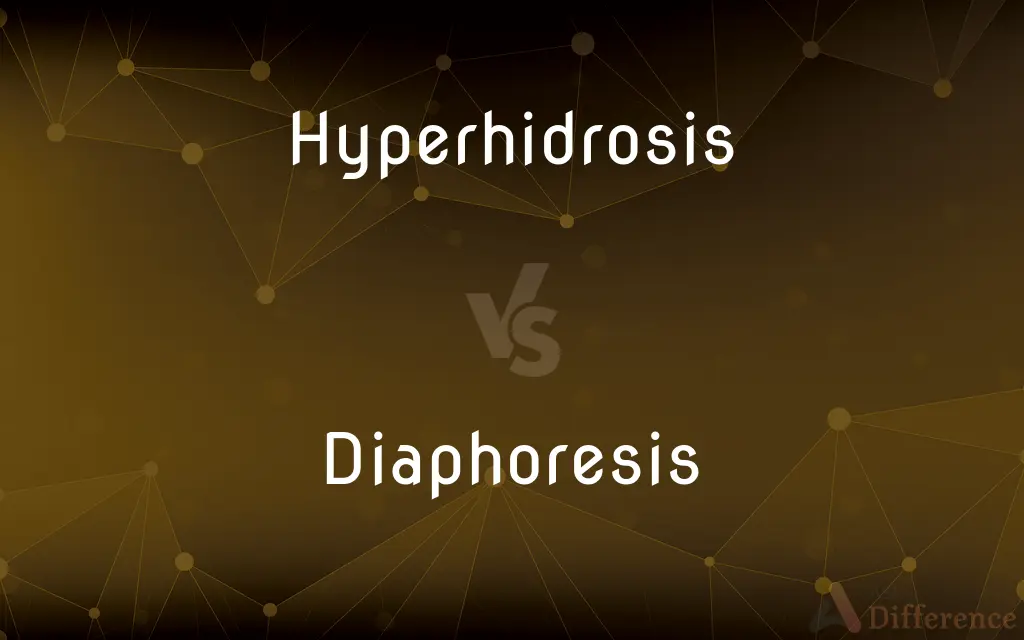Hyperhidrosis vs. Diaphoresis — What's the Difference?
By Tayyaba Rehman & Urooj Arif — Updated on April 1, 2024
Hyperhidrosis is a condition characterized by excessive sweating beyond physiological needs, often localized or generalized. Diaphoresis refers to sweating, typically extensive, that can be a symptom of underlying conditions or physical exertion.

Difference Between Hyperhidrosis and Diaphoresis
Table of Contents
ADVERTISEMENT
Key Differences
Hyperhidrosis is defined by abnormal, excessive sweating not necessarily related to heat or exercise, indicating an overactive sweat response. This condition can be embarrassing and disruptive, affecting specific areas like hands, feet, and armpits, or can be generalized across the body. Whereas diaphoresis refers to profuse sweating that can occur due to a variety of factors, including physical exertion, high temperatures, or as a symptom of medical conditions such as infections, hormonal imbalances, or cardiovascular issues. It is not a disorder in itself but a symptom that signals other underlying issues.
Individuals with hyperhidrosis may sweat excessively even in cool conditions without physical exertion, pointing to a hyperactive sympathetic nervous system. On the other hand, diaphoresis typically occurs as a body's natural response to need, such as cooling down the body during high temperatures or physical activity, or as a reaction to stress, fear, or pain.
Treatment for hyperhidrosis often involves addressing the excessive sweating itself through methods like antiperspirants, iontophoresis, Botox injections, or surgery in severe cases. Diaphoresis, however, requires identifying and treating the underlying cause, whether it be an acute condition like an infection or a more chronic condition such as diabetes or hyperthyroidism.
While hyperhidrosis can significantly impact quality of life and emotional well-being due to its persistent and often socially awkward manifestations, diaphoresis might not have a continuous impact unless it's indicative of a chronic or serious underlying health issue. Addressing hyperhidrosis focuses on managing symptoms, while diaphoresis treatment aims at resolving the root medical or environmental cause.
In social and psychological contexts, hyperhidrosis can lead to anxiety, social withdrawal, and decreased confidence, emphasizing the need for targeted treatment strategies. Conversely, diaphoresis, being a symptom rather than a condition, is treated within the broader context of patient care, addressing both the physical and psychological aspects of the underlying cause.
ADVERTISEMENT
Comparison Chart
Definition
A condition causing excessive sweating without physiological triggers
Sweating, often extensive, as a response to various factors including physical exertion or medical conditions
Primary Cause
Overactive sympathetic nervous system
Physical exertion, environmental factors, medical conditions
Treatment Focus
Managing and reducing sweat production
Treating the underlying cause of sweating
Impact on Life
Can severely affect social interactions and emotional well-being
Varied, depending on the underlying cause
Examples of Treatment
Antiperspirants, Botox, surgery
Addressing medical conditions, environmental adjustments
Compare with Definitions
Hyperhidrosis
A medical condition with overactive sweat glands.
She sought treatment for her hyperhidrosis to stop her palms from sweating excessively.
Diaphoresis
Sweating extensively, often due to exertion or heat.
After the marathon, her diaphoresis was evident by her soaked clothing.
Hyperhidrosis
Excessive sweating not related to heat or exercise.
Despite the cool weather, his hyperhidrosis caused his shirt to soak through.
Diaphoresis
Can indicate medical conditions when at rest.
His diaphoresis at night prompted a visit to the doctor.
Hyperhidrosis
Affects quality of life and social confidence.
Due to hyperhidrosis, he avoided handshakes to hide his condition.
Diaphoresis
May occur as a reaction to medications.
The new medication caused noticeable diaphoresis.
Hyperhidrosis
Often localized to specific areas like hands or feet.
His hyperhidrosis was particularly severe in his underarms.
Diaphoresis
A common symptom in fever, infections, or hormonal imbalances.
Diaphoresis during her illness made it difficult to stay comfortable.
Hyperhidrosis
Can be primary (idiopathic) or secondary to other conditions.
Her hyperhidrosis was diagnosed as primary, with no underlying health issues found.
Diaphoresis
Managed by treating the underlying cause.
Treating her thyroid issue reduced her diaphoresis significantly.
Hyperhidrosis
Hyperhidrosis is a condition characterized by abnormally increased sweating, in excess of that required for regulation of body temperature. Although primarily a benign physical burden, hyperhidrosis can deteriorate quality of life from a psychological, emotional, and social perspective.
Diaphoresis
Perspiration, especially when copious and medically induced.
Hyperhidrosis
(pathology) A medical condition with the primary symptom of excessive sweating, in excess of that required for regulation of body temperature.
Diaphoresis
The formation and excretion of sweat; sweating; perspiration; and (sometimes, more particularly):
Hyperhidrosis
Excessive and profuse perspiration
Diaphoresis
Excessive sweating; excessive perspiration (more than would be expected in response to a given stimulus; especially when profuse as a symptom of disease or a side effect of a drug).
Diaphoresis
Perspiration, or an increase of perspiration.
Diaphoresis
The process of the sweat glands of the skin secreting a salty fluid;
Perspiration is a homeostatic process
Common Curiosities
What primarily causes hyperhidrosis?
Hyperhidrosis is primarily caused by an overactive sympathetic nervous system leading to excessive sweating without typical triggers like heat or exertion.
Is diaphoresis always a bad sign?
Diaphoresis is not always a bad sign; it can be a normal response to physical activity or heat. However, it can also indicate underlying medical conditions, especially when occurring unexpectedly.
Can hyperhidrosis be cured?
While there's no cure for hyperhidrosis, treatments are available to effectively manage symptoms and reduce sweating.
Are there any lifestyle changes that can help with hyperhidrosis?
Lifestyle changes such as wearing breathable fabrics, using clinical-strength antiperspirants, and maintaining a healthy weight can help manage hyperhidrosis symptoms.
How do I know if my sweating is due to hyperhidrosis or diaphoresis?
If sweating is excessive and occurs without typical triggers like heat or exercise, it may be hyperhidrosis. Diaphoresis is usually linked to specific causes or conditions.
Can both hyperhidrosis and diaphoresis affect the same person?
Yes, someone with hyperhidrosis may also experience diaphoresis due to physical exertion, heat, or as a symptom of an underlying condition.
Are there any dietary factors that affect hyperhidrosis or diaphoresis?
Certain foods and drinks, such as caffeine and spicy foods, can exacerbate sweating in individuals prone to hyperhidrosis or diaphoresis.
Is hyperhidrosis more common in certain age groups?
Hyperhidrosis can affect any age group but often begins in adolescence or young adulthood.
Does hyperhidrosis only affect the underarms?
No, hyperhidrosis can affect various body parts, including the hands, feet, face, and underarms.
What should I do if I experience diaphoresis without any apparent reason?
Experiencing diaphoresis without a clear reason warrants medical evaluation to rule out or treat any underlying conditions.
Is diaphoresis a common symptom during a heart attack?
Yes, diaphoresis is a common and important symptom of a heart attack, along with chest pain, shortness of breath, and nausea.
Can psychological factors trigger hyperhidrosis or diaphoresis?
Psychological factors like stress and anxiety can trigger both hyperhidrosis and diaphoresis in some individuals.
Can hyperhidrosis be a side effect of medication?
Yes, hyperhidrosis can be a secondary condition caused by medications or other medical conditions.
Share Your Discovery

Previous Comparison
Meister vs. Master
Next Comparison
Flamenco vs. TangoAuthor Spotlight
Written by
Tayyaba RehmanTayyaba Rehman is a distinguished writer, currently serving as a primary contributor to askdifference.com. As a researcher in semantics and etymology, Tayyaba's passion for the complexity of languages and their distinctions has found a perfect home on the platform. Tayyaba delves into the intricacies of language, distinguishing between commonly confused words and phrases, thereby providing clarity for readers worldwide.
Co-written by
Urooj ArifUrooj is a skilled content writer at Ask Difference, known for her exceptional ability to simplify complex topics into engaging and informative content. With a passion for research and a flair for clear, concise writing, she consistently delivers articles that resonate with our diverse audience.














































